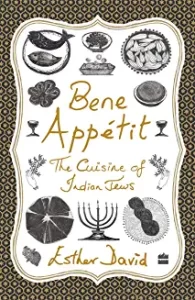Bene Appétit: The Cuisine of Indian Jews by Esther David; HarperCollins Publishers © 2021; ISBN 9789353-579579; 194 pages plus acknowledgments; $13.80 on Amazon.

 SAN DIEGO — Author Esther David tells of the history and cuisines of five Jewish communities in India –the Bene Israel, centered in Mumbai; the Cochin Jews on India’s southwestern coast around Kochi; the Baghdadi Jews on India’s northeastern coast around Kolkata (close to Bangladesh); the Bene Ephraim of Andhra Pradesh on India’s central eastern coast around Machilpatnam; and the Beni Menashe of Manipur and Mizoram on the northeastern arm of India bordering Myanmar (Burma).
SAN DIEGO — Author Esther David tells of the history and cuisines of five Jewish communities in India –the Bene Israel, centered in Mumbai; the Cochin Jews on India’s southwestern coast around Kochi; the Baghdadi Jews on India’s northeastern coast around Kolkata (close to Bangladesh); the Bene Ephraim of Andhra Pradesh on India’s central eastern coast around Machilpatnam; and the Beni Menashe of Manipur and Mizoram on the northeastern arm of India bordering Myanmar (Burma).
The food of all five communities comply with the laws of kashrut, but customs and traditions widely vary. In this review, I’ll mention some high points, but please understand the book includes many recipes and recitations of customs as a result of David’s excellent research and compilation.
The Bene Israel believe that their ancestors fled from Roman persecution following the destruction of the Temple in Jerusalem in 70 CE and were shipwrecked at the seaside town of Alibaug. According to local folk tradition, the Prophet Eliyahu’s chariot touched down in India briefly as he ascended to heaven. A rock in Khandala near Alibaug is believed to bear an imprint of the horses’ hooves and chariot wheels.
From Alibaug the Bene (Children of) Israel spread out along India’s northeastern coast on the Arabian sea, centering in Mumbai (previously known as Bombay). They brought the legend of Eliyahu the Prophet with them, devising a ceremony of thanksgiving called a malida which marked festive occasions such as engagements, weddings, brit milah, naming ceremonies, and bar/ bat mitzvah. Flaked rice, known as poha, is a base ingredient for the malida platter. The poha is mixed with grated coconut, garnished with raisins and chopped nuts, and accompanied with dates, apples, and bananas, and a variety of other fruits. “Sometimes an entire pomegranate is placed in the centre of the malida platter as a symbol of unity, or its seeds are sprinkled over the poha,” David writes.
(Pomegranates have long had a symbolic place in Judaism, in part because, by tradition, a pomegranate has 613 seeds, equivalent to the number of commandments given in the Torah.) Ashkenazic Torah Scrolls, when dressed, often are decorated with crowns shaped like pomegranates, called rimonim in Hebrew).
As part of the malida ceremony, Eliyahu Hanavi is remembered and thanked for this day of good fortune with participants chanting prescribed biblical verses.
For the most part, the Indian Jewish diet emphasizes fruits and vegetables, as well as fish, reflecting the fact that four of the five communities are coastal and the fifth gathered near lakes and streams.
The Cochin Jews are believed to be an amalgam of two groups: one that arrived in biblical times, prior to the onset of Christianity, and another believed to have fled from Spain at the time of the Inquisition. Over the centuries the two groups merged, becoming indistinguishable from each other. The Cochin Jews for years dominated the spice trade in India, causing them to be attacked by rival Portuguese interests and later restored to the trade by the Dutch. Given their long association with spices, it is perhaps unsurprising that many of their dishes involve blending various spices.
This is reflected even in one of the simplest recipes. For example, what David calls “Jewish Fried Chicken” finds the chicken seasoned with ginger-garlic paste, turmeric, black pepper powder, onions, curry leaves, red chili powder, garam masala, green chilies, tomatoes, vinegar, and salt.
The Baghdadi Jews of Kolkata brought with them their foods of the Middle East. However, over the centuries adaptations to the local fruits and vegetables were made, resulting in the fusion of two culinary cultures.
Imagine the chicken soup you might be used to. Now consider these ingredients boiled with the chicken: crushed garlic, pumpkin, bottle gourd, tomatoes, carrots, string beans, lemon juice and coriander leaves.
The biblical Joseph’s two sons were Ephraim and Manasseh (Menashe), who got along so well together that fathers even to today will express the wish that their sons may emulate them. One group of Jews in India claims descent from Ephraim, while another claims Menashe as their ancestor.
According to the origin story of the Bene Ephraim, they traveled from the Middle East across the Asian continent to China, and from there, about 1,000 years ago, found their way to India, where for the most part they live along the coast and in rural areas. Their staple food is fish curry and rice, according to author David.
To prepare curry in which to cook their fish, their recipe includes onions, oil, mustard seeds, curry leaves, ginger-garlic paste, green chilies, red chili powder, turmeric powder, cumin powder, tamarind extract, and coriander leaves. In a variation they will add two chopped tomatoes and/ or a cup of coconut milk.
The Bene Menashe of Manipur live inland so instead of saltwater fish, they frequently dine on freshwater fish from Loktak Lake or nearby streams. One method they utilize for cooking freshwater fish is to prepare it with such ingredients as salt, oil, ginger, onions and chilies and then placing it inside a bamboo hollow, which they seal with banana leaves. The fish inside the bamboo casing is rotated over a charcoal fire for approximately 30 minutes.
In Mizoram, David informs readers, “when any leafy vegetable is shredded and boiled in a vessel along with ginger, slit green chilies and salt, it is known as Bai, and is a traditional favorite of their cuisine. And when food is fried it is known as Kan. Bai and Kan apply to both vegetarian and non-vegetarian dishes like fish, meat, and chicken, which are cut into big pieces. On some festive occasions, they have pigeon or duck or bovine meat, which are either roasted or made into a soupy curry. Their method of cooking retains the original flavors of food with minimum spices and other ingredients.”
In a relatively short volume, one learns much about India’s Jews, their customs, and their foods. It is a commendable travelogue and recipe book.
*
Donald H. Harrison is editor emeritus of San Diego Jewish World. He may be contacted via donald.harrison@sdjewishworld.com